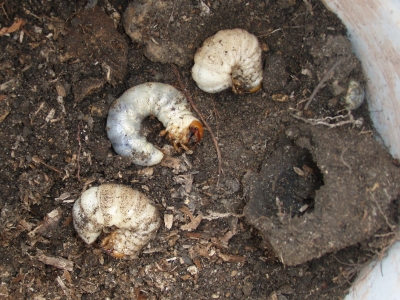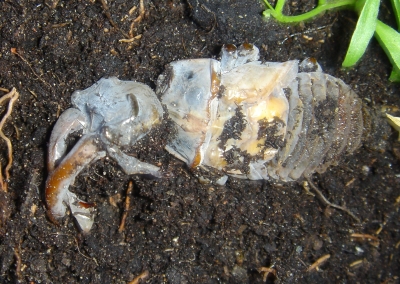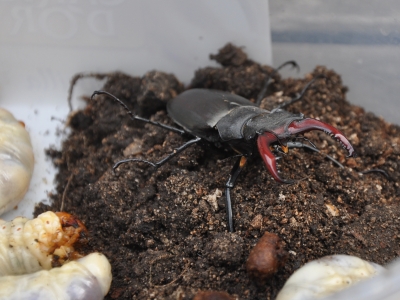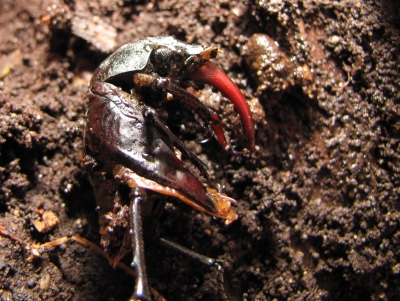When stag beetle Lucanus cervus larvae are ready to pupate they leave the wood in which they have been feeding and go to soil where they start preparing their cocoons. As this is the time when they are most vulnerable, not much field research has been carried out; in the literature pupation is often mentioned as occurring in the autumn except in a recent publication which mentions July *.
Some records of the Stag beetle “larval incidents” in private gardens survey agree with that timing thus contributing with important information about this stage in the wild.
Below are three photos which were taken when Lucanus cervus nests where inadvertently disturbed; coincidentally, these events timed the occurrence of cocoon making, pupation and eclosion stages at a great cost to the beetles, unfortunately.
|
 |
On the left is a photo of 3 stag beetle larvae and a broken cocoon which were found on 9 June 2010 in the soil by the roots of a dead sycamore tree (Acer pseudoplatanus).
Note that only the central larva had not emptied its gut; the others were clearly in the cocoon making stage.
Photo courtesy of Philip Cunningham, North East Essex.
|

|
Male stag beetle pupa on the point of eclosing.
It was disturbed on 24 August 2010 by the stump of a sycamore tree (Acer pseudoplatanus) which was cut 5 years ago.
Photo courtesy of Allan Vicent, Surrey.
|

|
Male stag beetle and some larvae found when a 6 years old cherry tree stump broke off, 12 September 2010.
The very good condition of this beetle strongly indicates that it had eclosed recently.
Photo courtesy of Dave Rix, Surrey.
|

|
Male stag beetle with strong deformities in its wings. Alas, during eclosion its wings somehow didn't move over to its back, otherwise it is fully hardened and coloured.
This beetle was found while monitoring a BB4B on 2 October 2010, and its stage of development fits well the others above.
Photo by Maria Fremlin, North East Essex.
|
These admittedly scant findings indicate that Lucanus cervus larvae probably start preparing for the pupal stage as soon as the soil is warm enough, around mid May in the UK; coincidentally this is when the adults get ready to emerge.
As we have seen in How stag beetle larva pupate it took one larva, in captivity, over 3 months to metamorphose into an adult, thus such an early start would allow for all the changes to be completed before the soil starts to cool down.
Indeed we have found that from early September adults were fully formed, ready to overwinter in a dormant stage deep in the ground.
In a species that reputedly likes it warm this is a vital strategy from the energy conservation point of view during its costly metamorphoses.
From the point of view of conservation it shows that their habitat should be left undisturbed from May till the end of September.
|
|
* Harvey, D.J., Gange, A.C., Hawes, C.J. & Rink, M. (2011) Bionomics and distribution of the stag beetle, Lucanus cervus (L.) across Europe. Insect Conservation and Diversity 4: 23-38. DOI: 10.1111/j.1752-4598.2010.00107.x
[PDF]
Acknowledgements:
I am extremely grateful to all the persons who so willingly have participated in the Stag beetle “larval incidents” in private gardens survey.
|



